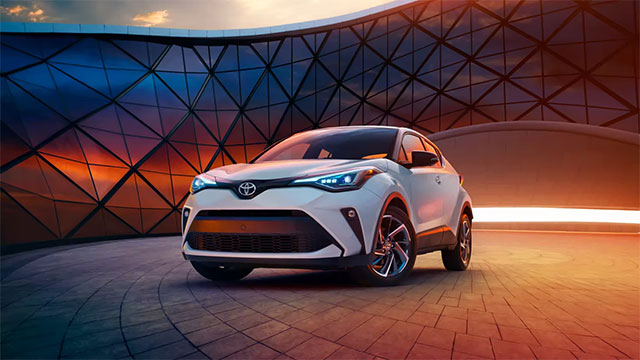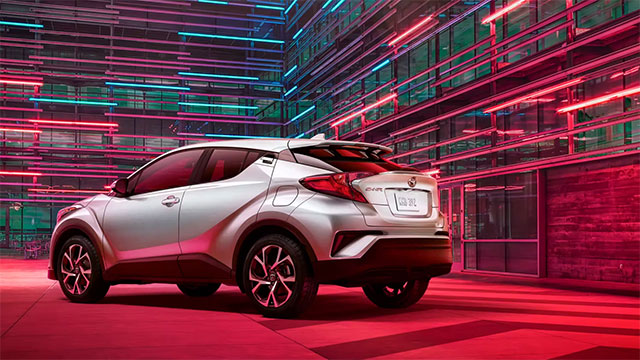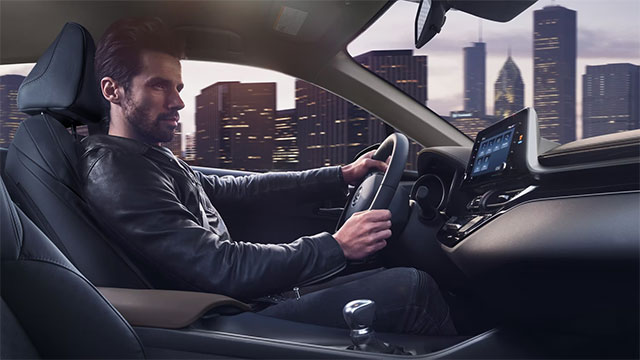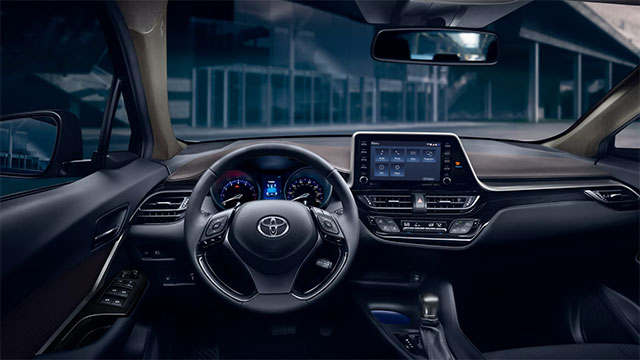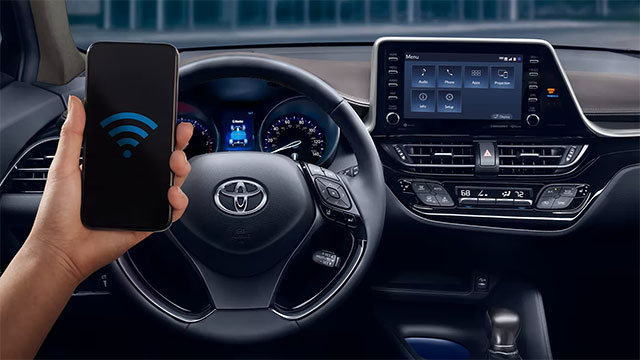The 2022 Toyota C-HR boasts a bold and striking exterior design that captivates onlookers with its unique curb appeal. However, behind the wheel, its driving experience is as mundane as it gets. Equipped with a lackluster four-cylinder engine, a dull CVT transmission, and front-wheel drive as the only option, the C-HR fails to excite. Accelerating is a tedious task, and handling on winding roads is nothing to write home about. On the bright side, the ride is relatively comfortable. The cabin space is on the cramped side for rear seat passengers, but otherwise, it is functional and practical. The C-HR’s quirky exterior design elements are reflected in the cabin, with an uneven dashboard, glittery black accents, and a textured headliner adding a touch of flair.
What’s new for 2022
The 2022 Toyota C-HR sees little change from its previous iteration, with the removal of the entry-level LE trim resulting in a higher starting price of over $24,000. The only notable update is the replacement of the Blizzard Pearl color with Wind Chill Pearl.
Table of Contents
2022 Toyota C-HR Review
Discover the 2022 Toyota C-HR – a stylish and fuel-efficient crossover with advanced safety features, comfortable seating, and easy-to-use technology.
Trim Levels, Powertrain & Handling
Toyota offers the 2022 C-HR in three trim levels – XLE, Nightshade Edition, and Limited – all powered by a 2.0-liter four-cylinder engine generating 144 horsepower and 139 pound-feet of torque. This power only goes to the front wheels via a continuously variable automatic transmission.
The C-HR’s powertrain is a major letdown, considering its sporty and agile handling capabilities. One can’t help but imagine how much more thrilling the driving experience would be with a turbocharged engine at the helm. The steering is responsive, providing a decent level of feedback, and when coupled with minimal body roll, the C-HR finally lives up to its dynamic appearance. Although the grip could be better, it’s not a significant issue as you won’t be pushing the limits of speed often. The brakes are reassuringly strong and simple to modulate.
Most of the time, the C-HR glides smoothly over everyday bumps and rough roads, providing a comfortable ride with supportive seats. However, road noise is quite prominent, and combined with the labored four-cylinder engine, it creates a less-than-serene cabin atmosphere, not inspiring the driver to reach the highest lawful speed. Overall, the C-HR’s road demeanors are passable but not outstanding.
2022 Toyota C-HR Performance Specs:
| Toyota C-HR Trims | Toyota C-HR Engines | Toyota C-HR Horsepower | Toyota C-HR Transmissions | Toyota C-HR Drivetrains | Toyota C-HR MPG/Combined |
| XLE | 2.0L Inline-4 Gas | 144 hp @ 6100 rpm | Continuously Variable Automatic (CVT) | FWD | 29 MPG |
| Nightshade | 2.0L Inline-4 Gas | 144 hp @ 6100 rpm | Continuously Variable Automatic (CVT) | FWD | 29 MPG |
| Limited | 2.0L Inline-4 Gas | 144 hp @ 6100 rpm | Continuously Variable Automatic (CVT) | FWD | 29 MPG |
Fuel Economy
Acceleration is not the C-HR’s forte, but the fuel economy rating is excellent. Its EPA estimates of 27 mpg city and 31 mpg highway put it on par with most rivals, but in real-world testing, the C-HR left the competition in the dust. The XLE model tested by Car&Driver exceeded its EPA rating, achieving a staggering 37 mpg over 200 miles, besting all but the Nissan Kicks. For further insights on the C-HR’s fuel efficiency, visit the EPA’s website for all the details.
Exterior
In the corner of the market where aesthetics reign supreme, the C-HR has plenty of curb appeal. Though it may look a bit peculiar from certain angles, such as the rear three-quarter view, details like the raised rear door handle, sharply slanted rear window, and bulbous fenders give it a unique identity. Every version of the car sits atop 18-inch alloy wheels, but their color and design differ across the trim options. The base models come with multi-reflector LED headlights, while the Limited trim features LED projector headlights and high-performance LED fog lights. The Nightshade Edition boasts a black chin spoiler and a number of other black elements, giving it a sporty and mysterious look.
Interior, Comfort & Technology
Stepping in and out of the C-HR is a breeze, thanks to its high seating stance. The front seat provides ample headroom, while the rear seats have adequate space to seat regular-size adults comfortably. However, they may feel a bit cramped due to the thick rear roof pillars.
The C-HR’s control layout is sleek and sophisticated, with most buttons and knobs a cinch to operate. However, some innovative facilities like adaptive cruise control can be a bit of a puzzle to work out. The front visibility is outstanding, but the heavy rear roof pillars can obstruct your vision to the rear.
The C-HR’s seats are sumptuous and helpful, and the suspension does an excellent job of evening out most bumps on the road. The cabin’s feel is superb for all occupants.
The C-HR may not be the best option for less-than-perfect roads. Edmunds observed that rough patches of pavement could easily disrupt the smoothness of the ride and generate excessive noise inside the car. The vehicle’s insulation from outside noise is subpar, and even a gentle flurry of wind can be fairly noisy inside.
The 2022 Toyota C-HR comes equipped with an 8-inch display supporting Android Auto, Amazon Alexa, and Apple CarPlay. A Wi-Fi hotspot, satellite radio, and a six-speaker stereo are also part of the package. The proximity keyless entry, push-button start, and dual-zone automatic climate control are optional facilities.
Practicality
When it comes to storage, the C-HR needs to catch up. The trunk area is near average for the segment at 19 cubic feet, and while you can fold down the rear seats to achieve 37 cubic feet of room, it’s still lacking compared to other vehicles. Up front, there’s enough space for little things, but the center console is subpar, and the cupholders are tiny and poorly positioned.
The rear seats could be better for families. Car seat anchors are located well, but fixing a rear-facing child safety seat will require shifting the front seats forward due to the limited space. The peculiar shape and size of the C-HR have resulted in a negotiated storage area, and Toyota missed the opportunity to add its trademark smart storage solutions.
Safety and Reliability
We love every car with driver assistance features, and the 2022 C-HR with the standard Toyota Safety Sense 2.5 suite impresses us a lot. Edmunds says the lane-keeping alarm system can be overly cautious in its notifications when you’re navigating winding roads, but it’s overall beneficial. The adaptive cruise control excels in diminishing driver exhaustion during heavy traffic and can bring the vehicle to a seamless stop.
Other standard driver assistance features available in the 2022 Toyota C-HR include lane trace assist, lane departure warning, forward collision warning with automatic emergency braking, pedestrian detection, road sign recognition, blind spot monitoring, and rear cross-traffic alert.
The Insurance Institute for Highway Safety (IIHS) could not test the 2022 Toyota C-HR. However, the 2021 model year earned top marks with a ‘Good’ rating in all six collision examinations.
The National Highway Traffic Safety Administration (NHTSA) also gave the 2022 C-HR an overall safety rating of Four out of Five Stars.
No recall issues have surfaced for the 2022 Toyota C-HR yet, but the preceding model, the 2021 C-HR, was recalled once due to a malfunctioning pre-collision system. The 2020 C-HR had to be recalled due to the rear seat belt being unable to secure passengers during an accident properly. The 2019 model faced the same recall as well as two other recalls, one of which was for a non-permanent text on the load capacity label and the other for rear axle-bearing bolts not being tightened enough. The J.D. Power rating for the 2022 Toyota C-HR is relatively high, scoring 80 out of 100, which suggests that the model has a solid overall performance, a positive experience for the owner, and a good level of reliability.
Competition
2022 Toyota C-HR vs Toyota RAV4
The Toyota RAV4 may not boast the bold styling of the C-HR, but it more than makes up for it with its spacious interior and plethora of standard features. Boasting over eight inches of extra body length, the RAV4 offers ample room for rear-seat passengers and a trunk that nearly doubles that of the C-HR. Despite its larger size, the RAV4 packs a punch with its bigger 2.5-liter engine, allowing it to tow over 3,500 lbs and outperform the C-HR in both speed and ground clearance. Though the C-HR may be more fun to drive, the RAV4 reigns supreme in terms of refinement. Though slightly pricier at $26,975, the RAV4 is worth the splurge for its superior SUV status.
2022 Toyota C-HR vs Honda HR-V
The Honda HR-V may not make as bold a statement as the Toyota C-HR with its design, but it offers a more practical and nice-looking option for the subcompact crossover market. With more rear legroom and ample space for luggage, the HR-V surpasses the C-HR in practicality. Though both vehicles feature noisy four-cylinder engines and CVT transmissions, the HR-V packs more power and accelerates with more urgency, thanks to its lighter weight and available AWD. The C-HR may have the edge in handling, but the more affordable and modest Honda comes out on top in this crossover showdown.
Toyota C-HR vs. Hyundai Kona
The Hyundai Kona reigns supreme in the subcompact SUV market, leaving the Toyota in its dust. With more robust engine options, higher fuel efficiency, a smoother ride, and ample cargo space, the Kona is a clear winner. Not to mention the bonus of available all-wheel drive and a more budget-friendly starting price of $2,700 less than Toyota. It’s no surprise that the Kona earned the title of 2022 Best Subcompact SUV for the Money from U.S. News for its unbeatable combination of quality and value.
Toyota C-HR vs. Mazda CX-30
When pitted against the Toyota C-HR, the Mazda CX-30 comes out on top in almost every aspect. From faster acceleration and nimble handling to superior fuel economy, the CX-30 offers more bang for your buck. Additionally, the CX-30 boasts more room for passengers and cargo, premium cabin materials, and a lower starting price of roughly $1,600 less than the C-HR.
Price and Warranty
The entry-level 2022 Toyota C-HR starts at $25,615. The Nightshade Edition goes for $25,860, while the range-topper demands $28,635.
Regarding warranty coverage, the Toyota C-HR leaves a bit to be desired. It only offers the standard limited and powertrain warranties of three years or 36,000 miles and five years or 60,000 miles, respectively, which is on par with most of its competitors. The only perk the C-HR has to offer in this department is its two-year complimentary scheduled maintenance. But for those who rack up high mileage, consider other options, such as the Kia Soul, which boasts more extended warranty periods.
Should I Go For The 2022 Toyota C-HR?
While Toyota is known for producing practical and reliable vehicles, the C-HR falls short compared to its rivals, such as the Honda HR-V and Kia Soul. Its small trunk, limited rear-seat space, and underpowered engine make it less well-rounded than other options in the market. However, the C-HR’s flashy styling and handling may appeal to a younger demographic. Additionally, it’s packed with modern safety features. If you only require a little space and primarily drive in the city, the C-HR may meet your needs, but for most buyers, other subcompact SUVs in the segment are a better choice.

